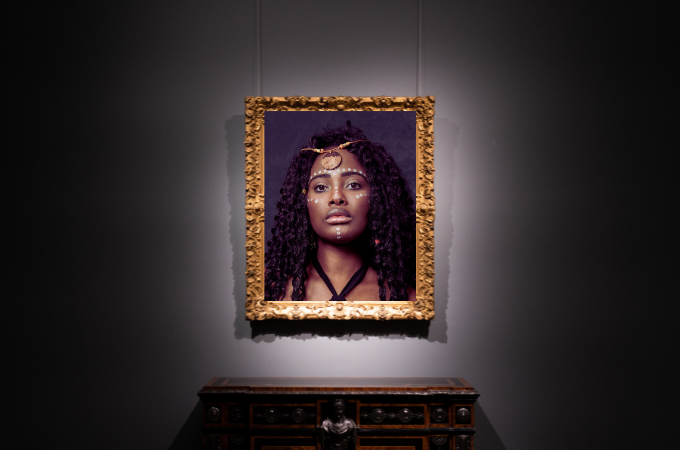
“Is it a folk tale or a fable?”
This was my grandfather’s uncanny way of challenging and educating me or as he liked to say, nourishing me through stories. Lullabies, fairy tales, fables and folk stories have been fed to me ever since I was an infant. And like food, the stories evolved as I grew up, with new layers progressively added. Sometimes the whole outlook of the story changed. How I laughed myself silly when the little child in Hans Andersen’s tale cried out, “Look, the emperor is naked.” By the time I reached my teens, Grandpa would end the same story with the rhetorical question, “Who is at fault? The vain strutting king, the subjects who fawn over the invisible clothes or the system which allows such a sorry state of affairs to continue?”
Daily, the stories poured in, very often taken from the Panchatantra tales but so often from our day-to-day life and in particular from our masters and rulers of the day. Like his last story in 1984, the year he died. He never got to tell me whether it was a folk tale or a fable.
***
Once upon a time, lived a king and a queen on an island. They ruled happily over the nation. Work was plentiful and people were merry. “May the king be blessed,” the citizens chanted. The king was flattered but humbly put it all to his wife.
“Behind every successful man, there is a woman,” he cried out for all to hear. He ordered for the queen’s wishes, each and every one of them, to be fulfilled. Gifts, unmatched in beauty, were brought from all over the world: diamonds from South Africa, emeralds from Colombia, rubies from Burma, now Myanmar, sapphires from Kashmir and the auspicious jade from China, all to be showered lavishly on her.
“A thing of beauty is a joy for ever,” said the poet. Yet for the king, the joy was short-lived. The gifts – mere gems – he reflected, could not do justice to the queen. He pondered day and night over the ideal present, which ever eluded him. Not even as a dream at night. Still, it did not prevent him from serenading,
“Without you
what will I do?
No joy for me
nor the populace, too.”
The queen smiled, to which he added in earnest, “I’ve been so selfish concealing you from the nation and depriving it of the holy wisdom.” At this, he wept. How could her wisdom be shared with the people, he reflected? No words could comfort him. He neglected his duties as ruler and the country suffered. People lost jobs. The children’s laughter, ever so contagious, stopped and the nation sank into despair. Yet the king did not step down. He could not renege on his divine rights. Instead, he convened a special meeting of the royal assembly. “There is only one way,” he announced, “to renounce the queen to share the loneliness of my people and their ignorance, starved of the holy wisdom.” The ministers dared not say anything. The last one who was brave enough had a finger cut off a few years back.
Dispirited, the queen was. Elated, she was even more. At the time, she was coveted only for her jewellery and sumptuous outfits. A loyal wife, she was, but above all, muted. Now she was on everyone’s lips, growing more influential each day. She pleaded with the king, in private, that she would not be able to survive his absence. She would wither and die. And this despite his loud snoring, which she wisely ignored. The king glowed. He reduced the lifetime self-imposed exile to a month instead.
The king ordered a palace room to be converted into a retreat. It included an annexe with an in-built library housing the world classics to while away the time in reading. Still, the days were long and the nights longer. At night, he howled like a wolf, in agony. Was he turning into a werewolf, unbridled, he wondered? His craving for her could no longer be suppressed. He had to see her again in the flesh. Or at least steal a furtive half-glance. Yet, it was not possible. A king is a man of his word. Under no circumstances could he fail to keep his promise. Rather die or take one’s own life than suffer ignominy.
He dug into the drawers, desperately looking for a sharp object to put an end to his agony. Instead, he uncovered an old photograph of the queen. It was a decade old, taken soon after the wedding: one of convenience. Was it not only in fairy tales that a princess was chosen by her shoe size? The nobility had its own ways and the royal blood, blue in colour, flowing in his veins was all-important. Blood that sprang directly from the gods, he was taught. Until one day in his childhood, he tripped and fell over a hoe, cut himself at the tibia, started bleeding and was rushed immediately inside. How surprised was he to find out that his blood was red?
Growing up, he received an exacting education, forcing him to forsake his weak traits: empathy and compassion. He understood by then he could not marry any commoner. Instead, he must choose one endowed with the fake blue blood. But he never had to bemoan it. On the contrary, he was now clinging to her picture for solace like a baby boy suckling his mother’s teats. The picture saved his life; in this way, he was able to keep his promise.
The queen put up a grand gathering to rejoice over the king’s homecoming. Festivities were held after a long time. People danced and made merry. The king was filled with joy to see the queen again. She could not help teasing him, though, “You are in splendid shape, your Majesty, and this despite my absence.” The festivities were grandiose and so was the dinner. Then came the awaited speech from the king. He revealed the pain and grief pangs that shook him during the night. He nearly died, he said, were it not for the picture of the queen. The crowd gasped. His people needed a spiritual guide on whom he had a divine revelation. The crowd gasped again. The portrait of the queen was the answer, he said. Suspended on the wall of each house, it will bring the citizens closer to her. In this way, they also will receive enlightenment. The festivities were coming to an end. People fainted. Was it too much booze? Or were they already receiving enlightenment from the queen?
The next day, the king decreed that each house be gifted with a portrait of the queen. The resolution was adopted unanimously by the council – like all resolutions. The work was set out to be completed in a week, just in time for the queen’s birthday. At last, he had hit upon the ideal gift and was pleased with himself. The government printer mobilised all the resources available for this mammoth task. Still, it was not enough. It was too tall an order. So, the printer curtailed the photographic processes to save time. The staff worked day and night. But they were pleased to be able to work again. People hoped for the best. They didn’t have a say anyway. Hundreds of thousands of citizens did not have access to the royal court or enjoy special favours and sweeteners. They were simply looking for jobs: the odd little ones.
A week later, the portrait of the queen was hung in each home. All but one. The royal palace, itself. The queen did not wish to see her own picture on the wall. When she was a little girl, her mother had told her the story of the princess, unmatched in grace and beauty, except for her own image. The princess could not since take her eyes off the mirror and stayed day and night gazing at it. She stopped eating. In the end, she withered and died. The story awed the queen. So much so that she got rid of all the mirrors. And there was no way now she would allow her picture to be hung on the palace wall. The king was cool about it. Didn’t he have the queen all to himself? He was overflowing with joy and could now set aside a little bit of his time for the affairs of the country.
The economy picked up, somewhat. Overjoyed, the king credited the nation’s recovery to the portrait. The queen swelled with pride. At the same time, something strange occurred in the kingdom, bordering on the miraculous. The queen’s face in the picture was growing bigger. People were either excited or frightened at this portent. Was it a miracle that confirmed the divine powers of the royal family? Or was it the hubris afflicting the royal palace?
The most brilliant scientific minds were called upon for explanation. They were baffled. Some bold theories, albeit weird, were put forward. The professor of physics at the university explained that the chemically sensitive photographic paper had not been washed off sufficiently and properly after exposure. The chemicals inside the paper were therefore still very much active. And the past effect of the enlarger lens during processing was causing the image to continue increasing in size.
The king and queen were unaware of the mysterious events. No one dared say a word to them. Eagerly, the king went on praising the queen who puffed up with pride. And each time, her face in the picture expanded again. Always in a symmetrical way. Until the left nostril of the queen, which was at the centre of the picture, took up the whole space. The portrait had now turned into an enormous black blotch.
In the coming days, the ever-present houseflies, mosquitoes, fleas and cockroaches became rare, hardly seen. The entomologists were puzzled. Was it a second miracle? One fine day, a housewife saw a fly hovering over the kitchen. An out of ordinary sight these days. She was delighted. For the first time in her life, she took the time to closely observe a fly and strangely, she found it pretty with its tiny wings: flimsy and delicate, glistening against the backlight. The fly entered the living room, and she excitedly followed it as it quietly landed on the revered portrait. It disappeared instantly. The picture was indeed drawing insects, very much like a magnet attracting a metal pin. The scientific community’s viewpoint was again sought covertly. It concluded unanimously this time that the black mass, once the official picture, was behaving like a black hole. All small-sized living creatures were inexorably pulled in, never to return. People rejoiced. They were pleased to see how useful and enlightening the portrait of their queen was. A simple, effective, and yet so green device.
Despite all the fuss, not a word reached the palace. Everyone feared the wrath of the king. So, the king and queen continued to live happily, blissfully unaware of the events around them. Until came harvest time, when it was the custom each year for the king and his queen to visit a few chosen subjects. To listen to their grievances, of which there were always none, and to show everyone that their king was a caring monarch. Furious, the king was on his very first visit, unable to discern the portrait. The hosts remained silent, petrified, and too scared to utter a single word. Their young daughter, like all children on the island, had been enthralled by the magic surrounding the picture. She was only too eager to break the story and recounted in her cute child-like manner the whole cycle of events. The queen recalled the eerie story of the princess. She went into a fit and hissed like a punctured balloon before fainting. At the same instant, a new miracle happened. The black blotch over the portrait shrank to a little black spot no bigger than a pinhead.
The populace was silent. The citizens feared the worst. In the end, they always suffered from the whims of their monarch. Now, it happened that a photographer had recorded on camera each stage of the portrait. The news spread out like wildfire. Soon, people from all over the world started pouring into the island to visit the photographer’s studio, which turned into a museum. The islanders call it the museum of laughter for the loud outbursts erupting from the visitors throughout the day. The peculiar sense of humour attracted people from all over the world. The islanders could now stand on their own feet. They catered for the needs of the visitors, offered good quality facilities, and made the island a high-end destination.
As to the king, he can sometimes still be seen on top of Light Mountain, the highest peak of the island, strolling idly around, chanting, “A picture, a picture, a kingdom for a picture.” Everyone lived happily ever after except that mosquitoes, flies and cockroaches spawned in huge quantities – a reminder to all of the fancies of the once-upon-a-time king.
***
In George Orwell’s novel, the year 1984 heralded the start of a dystopian era, which my grandfather foretold would last till people open their eyes to see through the invisible clothes. By chance, the prime minister also chose the same year to dignify his wife’s birthday by issuing new banknotes with her effigy. My grandfather had by then seen enough. So, he left the world peacefully. But his story lived on. Spread by word of mouth in an age of growing authoritarianism, it became a fable of derision throughout the island. Had he lived a few years longer, Grandpa would have revelled in seeing the laughed-at-banknotes withdrawn from circulation.
Photo by Nick van den Berg and Jackson David on Unsplash









COMMENTS -
Reader Interactions